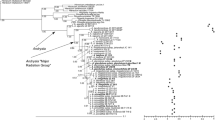Abstract
Trends concerning coevolution of mode of reproduction and genome size were elucidated by screening both components in 71 species/subspecies of the genus Hypericum. Two independent agamic complexes were identified (sections Ascyreia with ten, and Hypericum with five apomictic species). In the phylogenetically younger section Hypericum, the relative DNA content of apomicts is increased solely by polyploidy. The apomicts of the evolutionarily older section Ascyreia have significantly larger genomes than all other species due to polyploidization and higher DNA content per chromosome. An accumulation of retroelements might be one reason for the larger genomes. The male fertility of the apomicts was reduced compared to sexuals, although all apomicts were facultative pseudogamous, forming reduced male gametes. Another form of apomixis (obligate pseudogamous with unreduced male gametes), probably indicating an escape from interspecific sterility, was found in H. scabrum, the only case of asexual seed formation outside of sections Ascyreia and Hypericum. The described scenario for evolution of apomixis in relation to genome size deserves consideration in harnessing of apomixis.

Similar content being viewed by others
References
Arkhipova I, Meselson M (2000) Transposable elements in sexual and ancient asexual taxa. Proc Natl Acad Sci USA 97:14473–14477
Bennett MD, Leitch IJ (2000) Variation in nuclear DNA amount (C-value) in monocots and its significance. In: Wilson KL, Morrison DA (eds) Monocots: systematic and evolution. CSIRO, Melbourne, pp 137–146
Bennetzen JL, Kellogg EA (1997) Do plants have a one-way ticket to genomic obesity? Plant Cell 9:1509–1514
Bharathan G (1996) Reproductive development and nuclear DNA content in angiosperms. Am J Bot 83:440–451
Darlington CD (1939) The evolution of genetic systems. Cambridge University Press, London
Fedoroff N (2000) Transposons and genome evolution in plants. Proc Natl Acad Sci USA 97:7002–7007
Greilhuber J (1979) Evolutionary changes of DNA and heterochromatin amounts in the Scilla bifolia group (Liliaceae). Plant Syst Evol [Suppl] 2:263–280
Hammer K (2001) Guttiferae (Clusiaceae). In: Hanelt P, IPK (eds) Mansfeld's encyclopedia of agricultural and horticultural crops, vol 3. Springer, Berlin Heidelberg New York, pp 1345–1360
Hickey DA (1982) Selfish DNA: a sexuality-transmitted nuclear parasite. Genetics 101:519–531
Kidwell MG, Lisch DR (2000) Transposable elements and host genome evolution. Trends Ecol Evol 15:95–99
Kumar A, Bennetzen JL (2000) Retrotransposons: central players in the structure, evolution and function of plant genomes. Trends Plant Sci 5:509–510
Lihová J, Mártonfi P, Mártonfiová L (2000) Experimental study on reproduction of Hypericum × desetangsii nothosubsp. carinthiacum (A. Fröhl.) N. Robson (Hypericaceae). Caryologia 53:127–132
Matzk F, Meister A, Schubert I (2000) An efficient screen for reproductive pathways using mature seeds of monocots and dicots. Plant J 21:97–108
Matzk F, Meister A, Brutovská R, Schubert I (2001) Reconstruction of reproductive diversity in Hypericum perforatum L. opens novel strategies to manage apomixis. Plant J 26:275–282
Mogie M (1992) The evolution of asexual reproduction in plants. Chapman and Hall, London
Nielsen N (1924) Chromosome numbers in the genus Hypericum (a preliminary note). Hereditas 5:378–382
Noack KL (1939) Über Hypericum-Kreuzungen VI. Fortpflanzungsverhältnisse und Bastarde von Hypericum perforatum L.. Z Induk Abstamm Vererbungsl 76:569–601
Ohri D, Fritsch RM, Hanelt P (1998) Evolution of genome size in Allium (Alliaceae). Plant Syst Evol 210:57–86
Petrov DA (2001) Evolution of genome size: new approaches to an old problem. Trends Genet 17:23–28
Pupilli F, Labombarda P, Caceres ME, Quarin CL, Arcioni S (2001) The chromosome segment related to apomixis in Paspalum simplex is homoeologous to the telomeric region of rice chromosome 12. Mol Breed 8:53–61
Quarin CL, Espinoza F, Martinez EJ, Pessino SC, Bovo OA (2001) A rise of ploidy level induces the expression of apomixis in Paspalum notatum. Sex Plant Reprod 13:243–249
Robson NKB (1977) Studies in the genus Hypericum L. (Guttiferae). 1. Infrageneric classification. Bull Br Mus (Nat Hist) Bot 5:293–355
Robson NKB (1981) Studies in the genus Hypericum L. (Guttiferae). 2. Characters of the genus. Bull Br Mus (Nat Hist) Bot 8:55–226
Robson NKB (1985) Studies in the genus Hypericum L. (Guttiferae). 3. Sections 1. Campylosporus to 6a. Umbraculoides. Bull Br Mus (Nat Hist) Bot 12:163–325
Robson NKB (2001) Studies in the genus Hypericum L. (Guttiferae) 4(1). Sections 7. Roscyna to 9. Hypericum sensu lato (part 1). Bull Br Mus (Nat Hist) Bot 31:37–88
Robson NKB (2002) Studies in the genus Hypericum L. (Guttiferae) 4(2). Sections 9. Hypericum sensu lato (part 2): subsection 1. Hypericum series 1. Hypericum. Bull Br Mus (Nat Hist) Bot 32:61–123
Roche D, Hanna WW, Ozias-Akins P (2001) Is supernumerary chromatin involved in gametophytic apomixis of polyploid plants? Sex Plant Reprod 13:343–349
Wright S, Finnegan D (2001) Genome evolution: sex and the transposable element. Curr Biol 11:R296–R299
Acknowledgements
The authors thank many botanical gardens for their kind supply of seed samples, R. Fritsch for the collection of seeds from H. scabrum in Uzbekistan and Armenia, R. Rieger for critical reading of the manuscript and U. Tiemann for design of Fig. 1 as well as Leane Börner and Heidi Block for help with flow cytometric analyses, chromosome counting and determination of pollen stainability.
Author information
Authors and Affiliations
Corresponding author
Rights and permissions
About this article
Cite this article
Matzk, F., Hammer, K. & Schubert, I. Coevolution of apomixis and genome size within the genus Hypericum . Sex Plant Reprod 16, 51–58 (2003). https://doi.org/10.1007/s00497-003-0174-8
Received:
Accepted:
Published:
Issue Date:
DOI: https://doi.org/10.1007/s00497-003-0174-8




